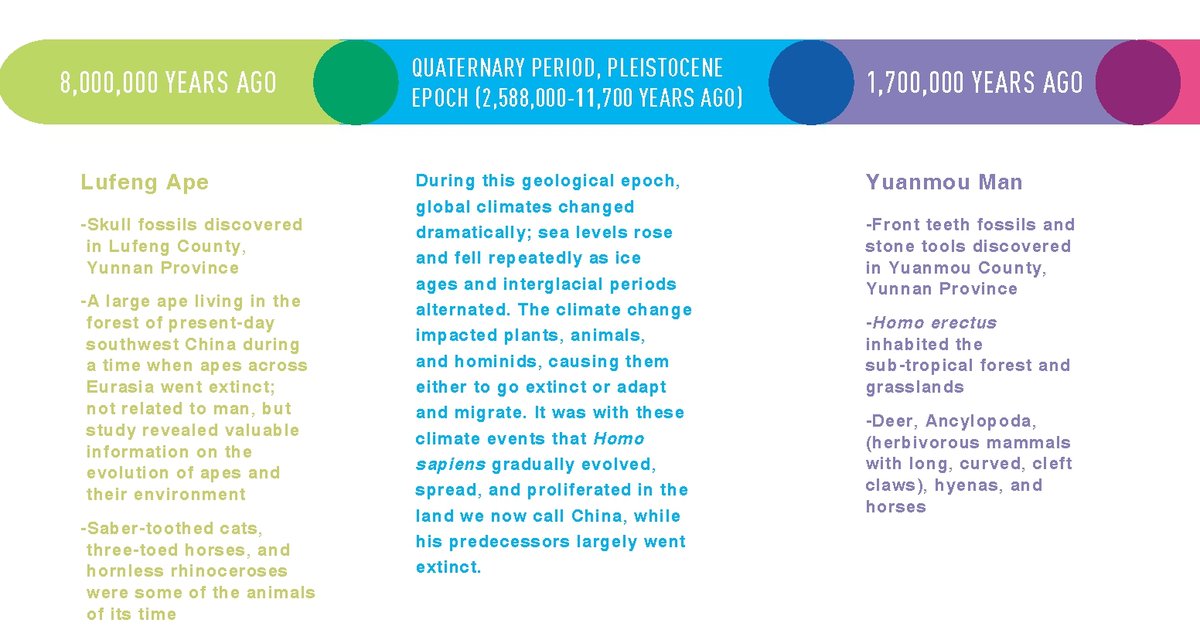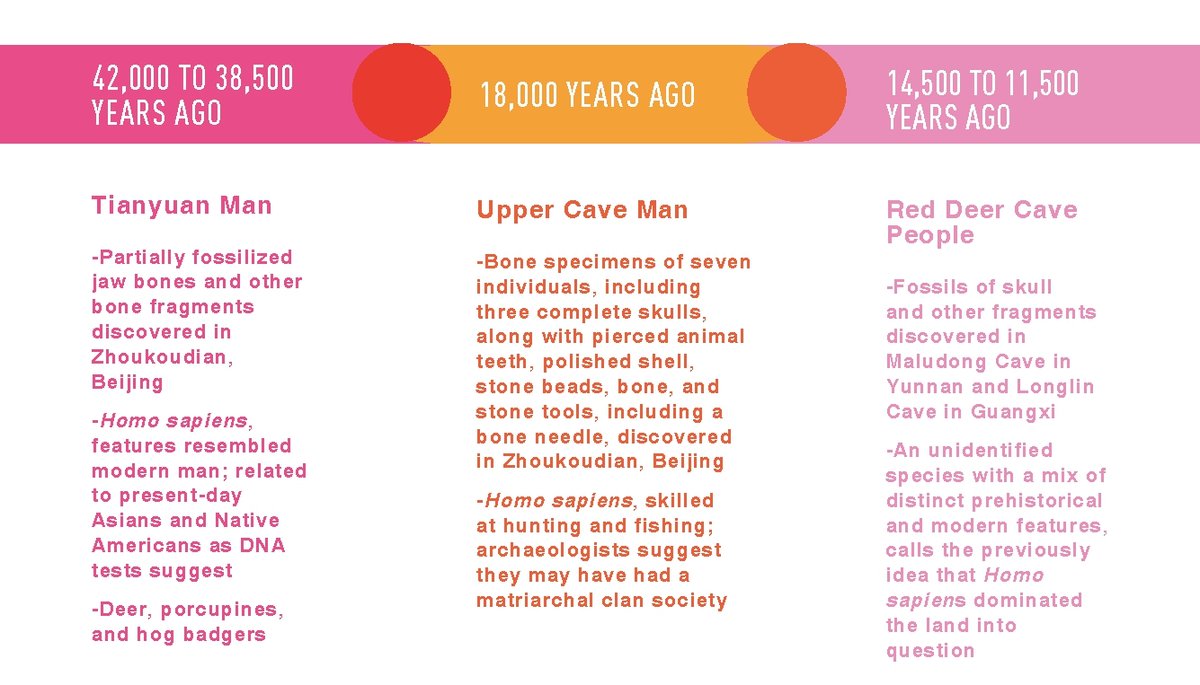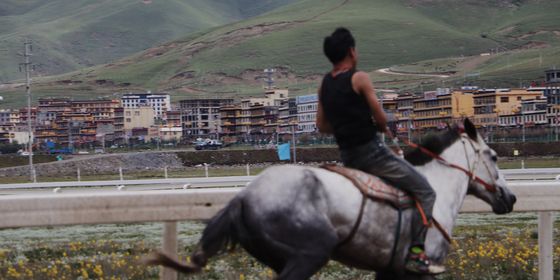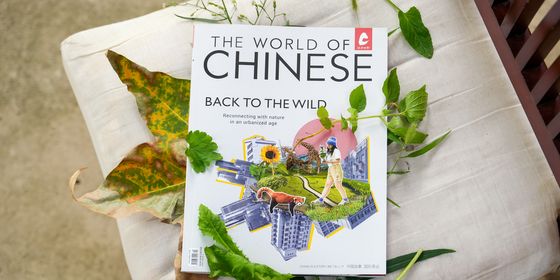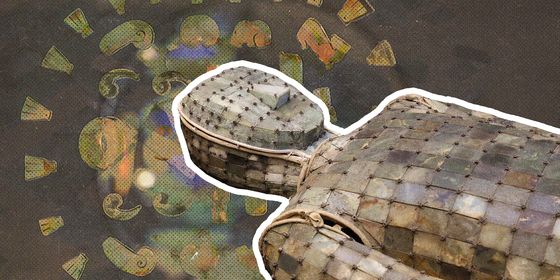Four discoveries of prehistoric humans in China and what they tell us about the origins of modern humanity
The beginnings of humankind can be a contentious subject. Irish Bishop James Ussher once set the date of creation (perhaps somewhat ludicrously) at just 4004 BCE, but in China there are family records that date back almost as far. Discoveries of human ancestors in China date back further—much, much further.
China’s rich geological diversity, along with its unparalleled fossil records and relics of early human activity, pose a question: What role did the land we know as China today play in the ascendance of humankind?
The Peking Man (北京人) is perhaps the most famous hominid resident of China. Unearthed from 1923 to 1927 at Zhoukoudian near Beijing, it was evidence of a transformative stage in human evolution from ape to human. It was classified as the genus Homo erectus, or “upright man.”
Unfortunately, most of the Peking man’s remains were lost when China fought off the invading Japanese in the 1930s and 40s. Deemed a national treasure, these lost fossils were the subject of international concern, sparking efforts to recover the remnants on land and by sea. Theories of the ancient remains’ whereabouts ran from the basement of a hospital to the imperial palace of Japan to the ocean floor.
Today, only the fossils of seven teeth, one humerus, one shinbone, one parietal bone, one occipital bone, and a section of jawbone remain in China, while three teeth are kept in the Uppsala University of Sweden. A fourth tooth was recently rediscovered in the university’s basement in one of the boxes sent from China for processing when the site was first excavated. This tooth somehow slipped through the cracks, only to be rediscovered to roaring headlines.
In 1987, Zhoukoudian was listed as one of UNESCO’s world heritage sites, and UNESCO emphasized its importance on its website by stating: “The Peking Man Site represents the most comprehensively and systematically studied site of Homo erectus…[it] also provides more precise scientific data for the study of the evolution, behavior, and paleoenvironment of Homo erectus than contemporary African and European sites.”
In the past, Chinese textbooks taught that the Peking Man was the ancestor of modern Chinese, but more recent DNA evidence has established that today’s Chinese people, like everyone else in the world, are descended from the hominid species Homo sapiens. They evolved in Africa and then settled around the world, while the Peking Man most likely went extinct. But a popular impression nevertheless remains that the Peking Man is somehow related to Chinese people, an argument best left to paleoanthropologists and biologists.
However, there have been other discoveries in China, perhaps less well known but equally fascinating, that have shaped our understanding of the human race’s journey to the present day:
Lufeng Ape
In early December in 1980, excitement was in the air in China’s southwestern Yunnan province. A group of scientists and local workers led by paleoanthropologist Wu Rukang worked feverishly on a small area where many fossils had recently been discovered. They were largely teeth, some of them even with jawbones attached.
It was a delicate task given the small range in which these fossils were scattered and overlapped. Just as one group was working on getting these pieces out unharmed, a loud cheer broke out from a neighboring dig site. A local worker held something in his hands and dashed toward the scientists yelling “Is this an old ape?” It was, in fact, just what they were looking for: the skull of an ancient ape.
The small colliery where the site is located is named Shihuiba, nine kilometers north of the county of Lufeng. Since 1975, when an ape molar fossil was discovered by accident, scientists have made many excavation expeditions in the hope of finding long-forgotten primates, and now they had found something of real value. The relatively complete skull fossil contains precious information, such as the creature’s facial features and brain size, providing invaluable insight into the evolutionary history of humanity’s relatives.
Initially, Wu believed it belonged to the same species as a previously discovered ape from the Indian Subcontinent, named “Rama’s ape.” But further investigation led to the hominid being assigned its new genus, Lufengpithecus, meaning “Lufeng ape.” Weighing around 50 kilograms, this large-bodied ape inhabited the area some 8 million years ago in the late Miocene Epoch. Elephants, saber-toothed cats, three-toed horses, and hornless rhinoceroses all lived in the Lufeng ape’s ecosystem. The face of the Lufeng ape was broad and short; its canine teeth were relatively low; and thick enamel covered its molars, which led to the belief that they ate tough vegetation as their main food source.
Arguments surrounding the Lufeng ape mainly center on whether it is a primitive hominid or a member of the Ponginae (a subfamily of apes that includes orangutans). Some suggest that the ape’s facial bones showed that it was better able to support itself in a bipedal posture. The international science community tends to favor the latter based on current evidence.
Even though the Lufeng ape was most likely not a human ancestor, its discovery was still precious. They existed during a time when apes went extinct throughout the rest of Eurasia, suggesting southern China was an important refuge for primates, including the ancestors of orangutans and gibbons. Their fossils provide an invaluable look into the environment and ecosystem of the time.
Scientists believed that the uplift of the Tibetan Plateau might have impacted the climate of the region, isolating it from the harsher environment elsewhere. They also suspect that the apes eventually went extinct because the weather grew drier and colder in the following Pliocene Epoch. The arrival of Homo erectus soon after may have also accelerated the process.
Yuanmou Man
On the morning of Labor Day in May 1965, three young geologists, Qiang Fang, Pu Yuqing, and Wang Deshan, set out early with hammers, chisels, and satchels. They were following leads from the villagers of a place called “Ten-Dragon Cross.” The villagers told a story of ten dragons that died and were buried there, but the young scientists suspected that the “dragon bones” were actually fossils of various mammals from the Quaternary Period—so they set out to find them.
The heat was almost unbearable that time of the year in the Yuanmou basin, by the Jingsha River in northern Yunnan. But it was well worth it. Soon, the geologists’ satchels were filled with fossils of animal teeth. At around 5 p.m., at the foot of a four-meter high mound, Qiang dug up two curious teeth that resembled human upper incisors, albeit thicker and stronger.
Elated, the three scientists spent their evening discussing whether they belonged to a giant ape or an early human. They compared them to tooth illustrations of the Peking Man and even their own teeth, but they still couldn’t confirm their suspicions. Eventually they wrapped the fossils and took them back to Beijing for experts to examine.
These were the fossil remains of the Yuanmou Man (元谋人), later confirmed by scientist Hu Chengzhi. Although only two teeth were found of this hominid, subsequent efforts excavated primitive stone tools around the site, which were likely used to hunt, cut down trees, and slice food. As a new species of Homo erectus, it was named “Homo erectus from Yuanmou” or H. e. yuanmouensis. Living 1.7 million years ago, even earlier than the Peking Man, the Yuanmou Man’s homeland featured subtropical forests and prairies, accompanied by now-extinct species of deer, Ancylopoda (a herbivorous mammal with long, curved, cleft claws), hyenas, and horses.
Coal dust was also found scattered around the site. While some jump to the conclusion that Yuanmou Man was using fire, an alternative explanation could just be that the grass had been buried and carbonized.
The two incisors discovered belong to an adult male hominid. The backsides of the incisors are curved like a shovel. A similar feature was discovered on the Peking Man, though with slight variations. A mysterious feature that caused much debate involved the shovel-shaped incisors—which are shared by about 90 percent of modern East Asian people, while only 10 percent of Africans have this feature.
Of all the hominid upper incisors (about 20 of them) discovered in China so far, all are shovel-shaped, despite the fact that they date from different periods. The Chinese paleoanthropologists also discovered other common features in Homo erectus remains: flat face, flat nasal saddle, quadrangular orbit, curved contours of the lower border of the cheekbone. These scientists, led by Wu Xinzhi, proposed that Homo erectus in China did not go extinct completely. Instead, they interbred with the later arrived Home sapiens, and passed down these features to modern Chinese people, an evolution hypothesis Wu called “continuity with hybridization.”
Lantian Man
The excavated Lantian Man (蓝田人) should technically be called “Lantian Women,” since the two fossil specimens belong to two females. They were excavated in two separate locations in Lantian county, Shaanxi province. The first location, Chenjiawo, was on the right bank of the Bahe River. Here in the red dirt lay the mandible of an old woman, dated between 600,000 and 700,000 years ago. A team of scientists from the Institute of Vertebrate Paleontology and Paleoanthropology discovered it during their field research. A variety of mammal fossils were also excavated, revealing Chenjiawo Lantian man’s contemporaries, such as the spotted hyena, wild boar, horse, and sika deer.
The second fossil specimen, however, was even more impressive. Lead scientist on the expedition, Huang Wanbo, still remembers how they came across it. The team was heading to the next town on their plan after finishing the excavation of the Chenjiawo fossil, but a rainstorm kept them in a small village on the road. When the rain stopped, the team found the loess slope along the Bahe River was heavily washed, revealing a clear soil profile—a great place to start hunting for fossils. The villagers were more than happy to point them to the right spot for some high quality “dragon bones.”
When scientists climbed the slope of Gongwangling, they found a narrow valley covered with bones that had been washed out by the rain. They dashed to the bottom of the valley and began to collect these fossils. Soon, more people were sent to investigate the rich fossil records. A year later, an excavator found a single tooth in a piece of calcic concretion; subsequent stone crafts were also discovered. Since the piece of calcic concretion could still contain hominid fossils, it was boxed as a whole and sent back to a lab in Beijing for more skilled analysis. Scientists were correct; a complete skull was discovered inside.
Dated between 1.1 and 1.15 million years ago, the Gongwangling fossil belonged to an adult female in her 30s. Her cranial capacity is estimated to be 780 cubic centimeters. Compared to the Peking Man (850 to 1,300 cubic centimeters) and modern humans (1,200 to 1,400 cubic centimeters), this puts the Lantian Man in a more primitive stage of evolution. Though fossils found in both locations were all listed under “Home erectus from Lantian” or H.e. lantianensis, some suggest the Lantian and Peking Man should be separately classified because of the discrepancies of the dating and apparent differences in features.
The intriguing aspect of the animal fossils also found at Gongwangling is their strong southern characteristics. Among them were the fossils of panda, stegodon, and tapir. This suggests that Lantian at the time was warm and humid, with a flourishing ecology. On the other hand, this means that the Qingling Mountain separating the north and south of China hadn’t yet risen, which allowed the animals to travel freely across the land.
According to Huang Wanbo, the Lantian man might not be native to Lantian after all. Like the southern animals, it was likely that they too migrated north from the Three Gorges area of the Yangtze River.
Tianyuan Man
Finally, we find ourselves back at the Zhoukoudian site. Not just a protected area, the site is still active to date with more than 20 locations holding various relics of early human activity, with new discoveries popping up from time to time.
In the spring of 2001, the forest farm on the site suffered from a drought. Since it was difficult to transport a large quantity of water to the site on the mountain, the manager of the farm, Tian Xiumei, decided to seek mountain springs with other workers to save their plants. They came upon a previously unknown cave later named Tianyuan Cave, five kilometers away from the original site.
According to Tian, she saw dripping water inside the cave and the earth was moist, so she decided to dig there for a natural spring. Instead, she discovered a many animal fossils. Two years later, an archeological team officially began their excavation, and within a month, found partially petrified jawbones, clavicles, a backbone, and other parts of a male hominid, as well as teeth of possibly another individual. Radiocarbon dating puts this early human between 38,500 and 42,000 years ago.
The fundamental difference between this hominid and the earlier Yuanmou Man, Lantian Man, and Peking Man is this: the Tianyuan Man (田园洞人) was a Homo sapien. In terms of anatomical features and morphology, they very much resemble us today. While Homo erectus, like Yuanmou Man, went extinct, Tianyuan Man was indeed related to modern Chinese people.
This is the result of a DNA test conducted by an international team of researchers in 2013, led by Qiaomei Fu and Svante Pääbo of the Max Planck Institute for Evolutionary Anthropology in Leipzig, Germany. Using the DNA lifted from a leg bone of a Tianyuan Man from 40,000 years ago, scientists were able to confirm a common origin shared by the Tianyuan Man and present-day Asians and Native Americans. They had also already diverged from the ancestors of present-day Europeans genetically.
“This individual lived during an important evolutionary transition when early modern humans, who shared certain features with earlier forms such as Neanderthals, were replacing Neanderthals and Denisovans, who later became extinct,” says Pääbo in a press release on the study by the Max Planck Institute.
Tianyuan Man lived in a relatively warm period of the Ice Age. The area was moist, covered by meadow steppes and forest steppes. Fruit was easy to find, with rich water sources, deer, porcupine, and at least 30 other animals living there. The small cave provided the Tianyuan Man with shelter from harsh weather and natural disasters. Isotope analysis also revealed that Tianyuan Man ate a great deal of freshwater fish. Black marks were found on some of the bone fossils, likely evidence of fire usage. Until about 20,000 years ago when the warm period ended, Tianyuan Man lived there for many generations. The cold drove the animals away, and the Tianyuan Man eventually abandoned the cave and migrated to warmer areas.
Many branches of human evolution have lived, thrived, and died on the vast tracts of land that make up modern China. Their varied fates have provided curious modern minds with a unique look into the immense changes our planet has gone through, as well as a rare glimpse into the history of humankind.
This is a story from our archives. It was published originally published in 2015 and has been edited and republished in honor of TWOC’s upcoming 100th issue celebrations. Check out our subscription plans and discounts that will give you access to more great stories!







